Introduction
The cricket battlefield is competitive and challenging. Players have become extremely professional and disciplined about their training. Companies have optimized the weight of the bat, material of the bat, length of the handle, design of the shoes and what not to ensure top performance from the players. The cut-throat competition doesn’t make it easy either. In spite of all the hoopla, a few players still make it to the top. They raise the bar of the game every time they walk to the field.
Who rules the cricket pitch across the globe for ODI, Test and T20?
Have you ever pondered over this question? Well – we have and to find out the answers we decided to do an in-depth analysis of best reigning batsmen in the cricket fraternity today. Whether you are a cricket fan or not, this questions must have piqued you to find answers further. Here is a major analysis of this question the world has been asking.
P.S. If you are not a cricket fan, today’s article might not be for you. And if you are, you are in for a treat!
Player Selection Criterion
Before we begin, I am sure the first questions that must have popped in your head is how to choose a consideration set for players. Who are the best batsmen in the world? The player selection parameters can be confusing and difficult. So, how did we reach an agreeable state for player selections? And which four players made to our list?
For the analysis purpose, we used following criteria to select the players:
- Player must be in Top 5 players of Test Cricket (ICC Ranking) currently
- Player should be below the age of 30 (we are looking at a player with at least a few years ahead of them)
- Player must play all three format of cricket (Test, ODI, and T20)
So after applying these filters, we were left with four remarkable test batsman (as per ICC Ranking): Steven Smith, Virat Kohli, Joe Root and Kane Williamson. We are keeping Amla out of the analysis because of his age. Although he is one of the most dominating cricketer of world cricket with a good average across Test and ODI.
I also want to mention the multi-talented cricketer (hope you guessed it right), ABD The ABD. He can hit a ball in any part of the ground but again his current statistics and age are not satisfying our selection criteria.
Current Standing across all the formats
Let’s start with the obvious – The current ICC rankings of all the four players across all the formats of the game.



Framework for comparison
For the analysis, all the four players will be judged on the following parameters across all the three formats of the game, i.e, ODI, Test, T20.
- Consistency: To compare player over consistency, we will look at the following metrics:
- ICC ranking over last 3 years
- Average over innings
- Performance Home Vs Away
- Performance Scoring Vs Chasing (In Test cricket, 1st and 3rd inning is considered as scoring whereas 2nd and 4th inning as chasing)
- Player Dominance: Metrics considered are:
- Conversion Rate (the 50s to 100s)
- Man of the match / number of matches played
- Hitting Capacity / Patience: We have looked at the Average number of ball faced per match in test cricket whereas in ODI and T20, Strike rate and runs contribution by 6s and 4s so metrics are:
- Strike Rate (ODI and T20)
- Runs contribution of 4s and 6s (ODI and T20)
- Average balls faced per match (Test cricket)
- Winning Contribution: Metric considered is “Man of the match/Number of time team wins
- Dismissal Pattern (Optional): It is not a comparison metrics but want will provide us interesting insights.
Now, let’s look at the each format and compare the four remarkable players on the above metrics.
Test Matches
1.Consistency
The consistency of a player is defined by two criteria:
A) Consistency in ICC Rankings over the years
B) Average over the innings
So let us first look at the trend of ICC Rankings of all the four players over the years starting from 2013.
A) ICC Rankings Over last 3 years

It looks like Joe Root was on Turbo mode from 2013 to 2015 surpassing other players but what catches the attention is the growth of Kohli from 14th rank in 2015 to 2nd position in 2016. This is especially intriguing keeping in mind that Kohli is at the top positions in other formats too. Everybody knows the aggressiveness which Virat Kohli has on the field but test matches demand an entirely different outlook and we think Kohli understood it well in 2015.
B) Average Over Innings
It certainly can’t be denied that a good average is an indicator of a good player and a consistent average is what makes a player dependable. Let us look at the average of all the four players over the course of their innings to see if we can generate an inference about their performance.
As it can be seen Joe Root and Kane Williamson started off with an excellent opening in their career but their performance graph dipped later on. After 70 innings into their careers, Steven Smith rules the average turf. Meanwhile, it is worth noticing that Kane Williamson has shown a constant increase in his average score over the innings and I would say he is one hell of a player to bet your money on. Whereas, Kohli attained a constant average score early into his career and has maintained it so far. But these are just the overall average of each player and only shows you the outside picture. Interesting insights emerge when we break this down into two categories:
C) Chasing Vs. Scoring
D) Away Vs. Home
C) Chasing Vs. Scoring
Various exciting insights can be drawn from the above graph, like:
- Steven Smith is the man for setting scores and giving a hard time to the team who chases.
- Under pressure, Virat Kohli outperforms every other player by a significant margin.
- Joe Root doesn’t care whether his team has to score or chase. He will consistently perform as he usually does.
The only insight that is clearly visible is Steven Smith beating down the other three players both in Home conditions and Overseas.
Who wins on Consistency: Steven Smith
2. Player Dominance
Player Dominance is the percent of the time a player has been able to put up a show as to mark his presence in every game he has played. Player Dominance here is measured by two factors:
A) Conversion Rate
B) Man of the Match / Number of Matches played
A) Conversion Rate
It is the ability of a player to play big knocks and provide the team with the winning runs. Not everybody is capable of playing bigger knocks. Let us look at the conversion rate of all the four players and see which player has the capability to score big runs.
It is clearly evident that Virat Kohli is the player who once settled, goes for the big runs. So it is advisable to restrict him before 50 otherwise he is more likely to convert that 50 into 100.
B) Man of the Match/ Number of matches played
This ratio is representative of the degree of dominance of the player in the matches played.

From the graph, it is evidently clear that Steven Smith steals the show in terms of number of Man of the Match per game played with Joe Root behind in the second position.
So, after combining the two results it is Steven Smith who is more dominating in comparison to the other three players.
Who wins on Dominance: Steven Smith and Virat Kohli.
3. Patience (Average balls faced per inning)
Test matches require a lot of patience to hold on to the pitch the entire facing hundreds of balls. Let us look at the graph below to see which player fares better than the rest in terms of the number of balls faced per innings.
 It is easy to observe that Kane Williamson is the most patient cricketer of all the four but difference is not big.
It is easy to observe that Kane Williamson is the most patient cricketer of all the four but difference is not big.
Who wins on Patience: Kane Williamson
4. Winning Contribution
Winning Contribution is determined by metrics “MoM / Number of times team won”.
MoM / Number of times team won
 As can be seen from the graph that Joe Root has the higher percentage of winning contribution than the rest.
As can be seen from the graph that Joe Root has the higher percentage of winning contribution than the rest.
Who wins on Winning Contribution: Joe Root
5. Dismissal Pattern
Though this is not a judging criterion but it will be exciting to know about the dismissal patterns of all the four players. This will let us know their preference of bowlers.
It seems Steven Smith is better at protecting wickets against pace bowlers while Joe Root is the one who can play spinners well.
Note: The ratio is calculated w.r.t innings rather than matches
Another insight is Virat is much more capable than the other players at not getting bowled. With getting 5 times bowled out of 89 innings, this is an interesting insight.
The Test Verdict
Seeing the all the parameters for Test Matches, you can see that all the four players are at the top on different parameters although it is clear that Steven Smith wins 2 of all four parameters so Steven is the man for test matches.
One day International (ODI)
Now is the turn for limited hours format. We will be evaluating players on the same criteria similar to test matches. So let’s begin.
1. Consistency
The consistency of a player is defined by two criteria:
A) Consistency in ICC Rankings over the years
B) Average over the innings
So let us first look at the trend of ICC Rankings of all the four players over the years starting from 2013.
A) ICC Rankings

Do you see the flat line in dark blue color? Yes, that indicates Virat Kohli occupying the top spot since 2013. This symbolizes the consistency of Virat Kohli in ODI format. While the other three players have almost caught up in 2016, they still have a lot to catch up.
B) Average Over Innings
It certainly can’t be denied that a good average is an indicator of a good player and a consistent average is what makes a player dependable. Let’s look at the average of all the four players over the course of their innings to see if we can generate an inference about their performance.

As it can be seen Joe Root started off to an excellent start in his career but his graph dipped midway. After 40 innings, Joe Root has shown a constant increase in his average over innings. Meanwhile, it is worth noticing that Kane Williamson has shown a constant increase in average over the innings and he is one hell of a player to bet your money on. Whereas, Kohli attained a constant average during his mid-career and has maintained it so far and currently it is higher than all of them.
C) Chasing / Scoring
Various exciting insights can be drawn from the above graph. Like:
- Joe Root is the man for setting scores and giving a hard time to the team who chases.
- Under pressure, Virat Kohli outperforms every other player by a significant margin.
- Another interesting thing to note is that Root, Williamson and Smith score better while setting targets whereas Virat Kohli is the only batsman to score better while chasing in comparison to setting targets.
Now there are some interesting insights that can be derived from the above graph:
- Everyone except Joe Root performs better in Home Conditions rather than Overseas.
- Steven Smith is the best performer in Home conditions whereas Joe Root holds the top spot overseas.
Who wins on consistency: Virat Kohli
2. Player Dominance
Player Dominance is the percent of the time a player has been able to put up a show as to mark his presence in every game he has played. Player Dominance here is measured by two factors:
A) Conversion Rate
B) Man of the Match / Number of Matches played
A) Conversion Rate
It is the ability of a player to play big knocks and provide the team with the winning runs. Not everybody is capable of playing bigger knocks. Let’s look at the conversion rate of all the four players and see which player has the capability to score big runs.
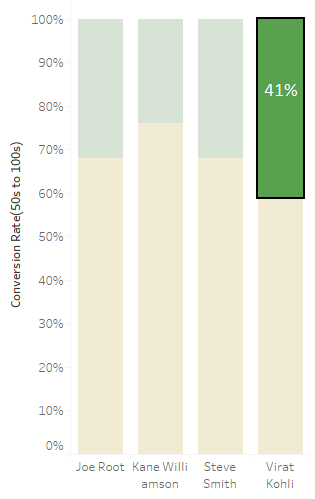
It is clearly evident that Virat Kohli is the player who once gets settled goes onto making big runs. So it is advisable to restrict him before 50 otherwise he is more likely to convert that 50 into 100.
So, after combining the above two results we reach a conclusion that Virat Kohli happens to be more dominating in comparison to the other three players.
B) Man of the Match / Number of matches played
This ratio is representative of the degree of dominance of the player in the matches played.
From the graph, it is clearly evident that Virat Kohli steals the show for player dominance with the highest ratio for Man of the match per game played. And Kane Williamson stands at the second position.
Who wins on Player dominance: Virat Kohli
3. Hitting Strength
Hitting Strength of a player is calculated by two factors:
A) Strike Rate
B) Number of 6’s and 4’s
A) Strike Rate
Strike Rate plays an important role in the One Day format since it is equally important to score big runs as well score them fast. Let’s look at the below strike rate graph of all the four players to see who likes to take it aggressive on the pitch.

Well, once again it is Virat Kohli leading the race followed by Steven Smith.
B) Number of 6’s and 4’s
It is difficult to decide the winner amongst the cricketer who likes to send the balls out of the ground. Kane Williamson and Virat Kohli are the players who like to score their runs mostly in 4’s and 6’s.
Who wins on Hitting Strenght: Virat Kohli
4. Winning Contribution
Winning Contribution is determined by the ratio of number of Man of the Matches to the Number of times team won.
MoM / Number of times team won

As can be seen, it is Virat Kohli who has contributed the most out of all the four players to the number of times a team has won the match.
Who wins on Winning Contribution: Virat Kohli
5. Dismissal Pattern
Though this is not a judging criterion but it will be exciting to know about the dismissal patterns of all the four players. This will let us know their preference of bowlers.
Joe Root happens to be the most vulnerable of the four players against fast bowlers whereas Virat Kohli is the best batsman against spin bowlers.
Note: The ratio is calculated w.r.t innings rather than matches
The ODI Verdict
Virat Kohli has constantly featured at the top position across various parameters and has emerged as the most influential batsman amongst all the four players in ODIs.
T20
The consistency of a player is defined by two criteria:
A) Consistency in ICC Rankings over the years
B) Average over the innings
So let us first look at the trend of ICC Rankings of all the four players over the years starting from 2013.
A) ICC Rankings
There are two interesting trends that can be seen in the graph above:
- The consistency of Virat Kohli at the top spot of ICC T20 rankings since 2013. This is a similar trend to that of ODIs. It seems like Virat Kohli enjoys limited over formats more than Test Matches.
- The almost disappearance of Steven Smith from the T20 ranking scenario. It can be very well inferred that Steven Smith belongs to the long race breed of horses.
B) Average Over Innings
There is no denying that a good average is an indicator of a good player and a consistent average is what makes a player dependable. Let us look at the average of all the four players over the course of their innings to see if we can generate inference about their performance.
As it can be seen that Joe Root started off to an impressive start at the beginning of his career and remained almost constant at a score of around 40 for the rest of his T20 career. But the most exciting trend is exhibited by Virat Kohli who after his 20th inning has shown a constant and enormous increase in his T20 average. Meanwhile, Kane Williamson and Steven Smith have a lot to catch up in this format.
C) Chasing/Scoring
Various exciting insights can be drawn from the above graph.
- Virat Kohli is the man for setting as well as chasing scores and giving a hard time to the opponents.
- Under pressure, Virat Kohli outperforms every other player by a significant margin.
- Unlike the other two formats, all the four players perform significantly well while chasing rather than scoring.
D) Home / Away
The only insight that is clearly visible is Virat Kohli taking down every other player on the overseas ground whereas it is Kane Williamson who outperforms everybody in home ground.
Who wins on consistency: Virat Kohli
2. Player Dominance
Player Dominance is the percent of the time a player has been able to put up a show as to mark his presence in every game he has played. Player Dominance here is measured by metric “Man of the Match / Number of Matches played” in T20 cricket.
Man of the Match/ Number of matches played
This ratio is representative of the degree of dominance of the player in the matches played.
Virat Kohli has time and again proved that he is a master at the limited over format. Here too, the blue bars signifies the mastery Virat Kohli has over limited format game.
Who wins on Player Dominance: Virat Kohli
3. Hitting Strength
Hitting Strength of a player is calculated by two factors:
A) Strike Rate
B) Number of 6’s and 4’s
A) Strike Rate
Strike Rate plays an important role in the T20 format since it is equally important to score big runs as well score them very fast. Let’s look at the below strike rate graph of all the four players to see who likes to take it aggressive on the pitch.

With a marginal difference, Joe Root leads the race with Virat Kohli behind. The greater the area in the above graph more is the strike rate.
Number of 6’s and 4’s
Insights:
- In terms of a number of 4’s hit, it is Kane Williamson who leads the show.
- In terms of 6’s, it is Steve Smith who is at the front.
- But at above all level you can see that Joe Root has higher contribution from 4’s and 6’s.
Who wins on Hitting Strength: Joe Root
4. Winning Contribution
Winning Contribution is determined by factor “MoM / Number of times team won”
MoM / Number of times team won
As can be seen from the graph that Virat Kohli has a higher percentage of winning contribution than the rest followed by Joe Root.
Who wins on Winning Contribution: Virat Kohli
5. Dismissal Pattern
Though this is not a judging criterion but it will be exciting to know about the dismissal patterns of all the four players. This will let us know their preference of bowlers.
It seems Steven Smith is better at protecting wickets against pace bowlers while Kane Williams0n and Virat Kohli are the one who can play spinners well.
Note: The ratio is calculated w.r.t innings rather than matches.
The T20 Verdict
It is Undoubtedly Virat Kohli. Once again this can be attributed much to the IPL influence with Virat getting regular practice in 20 over formats. But nonetheless, the answer is Virat Kohli.
What does the analysis say about the four players?
As per the above analysis, we can conclude that Virat Kohli happens to rule the ODI and T20 cricket pitch. He has shown consistent performance increase and has proved to be one of the promising players till now.
Disclaimer: The above analysis is not subject to any personal bias but is purely on the basis of the data and facts available.
End Notes
I hope you enjoyed reading this article. What are your views on this analysis? Do you agree or disagree? Share your opinions with us in the comments section.
Through this article, we have tried to show you how analytics can be used for different applications. If you have any doubts/ confusions then feel free to post your questions below.


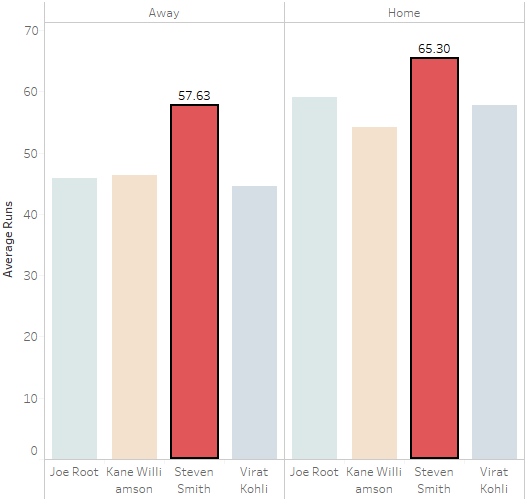



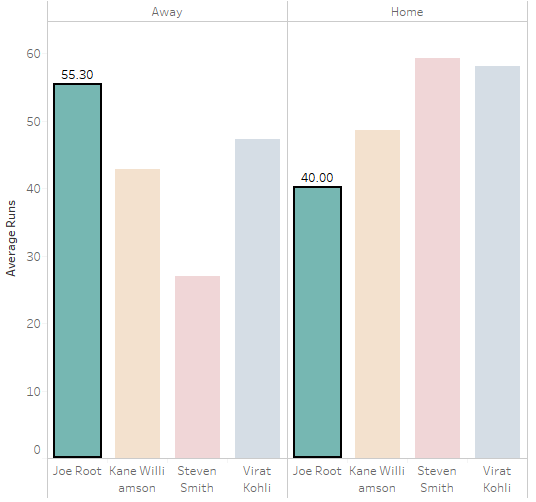

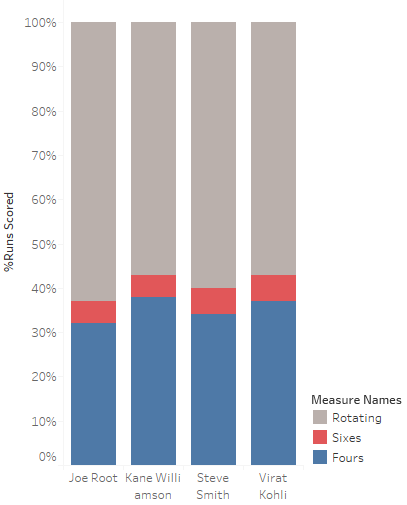


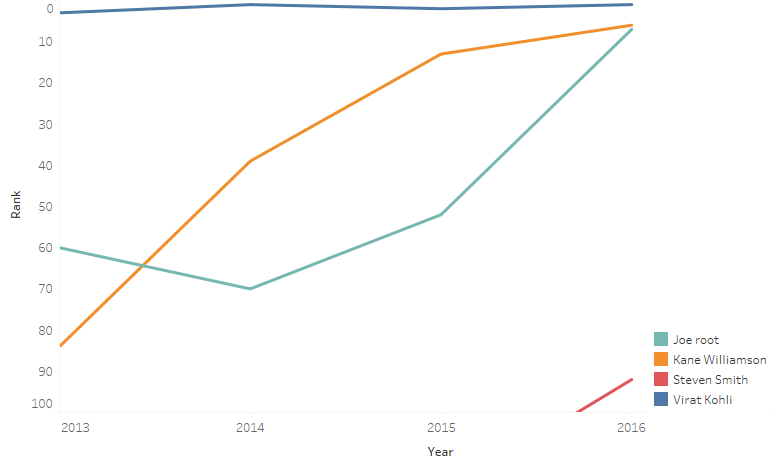

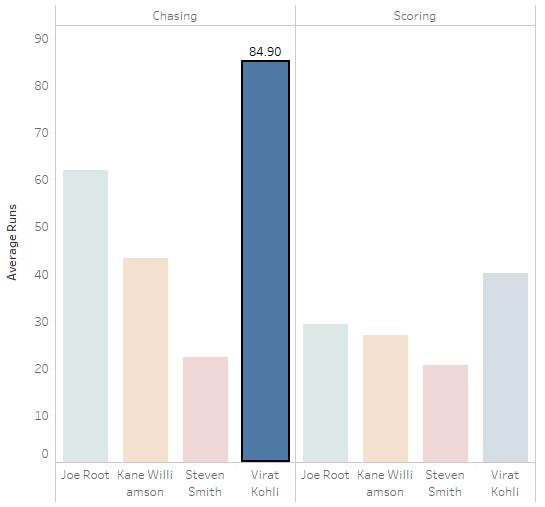

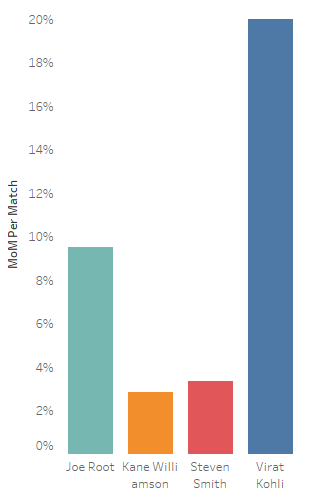
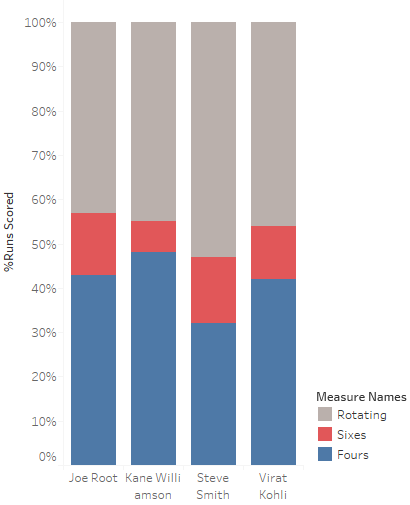










would like to know more about the data - primarily the source, how was it cleaned into the analysis, issues with the data that you have faced.
Superb!!
Hi thanks for this analysis. Can you please share the data used for this